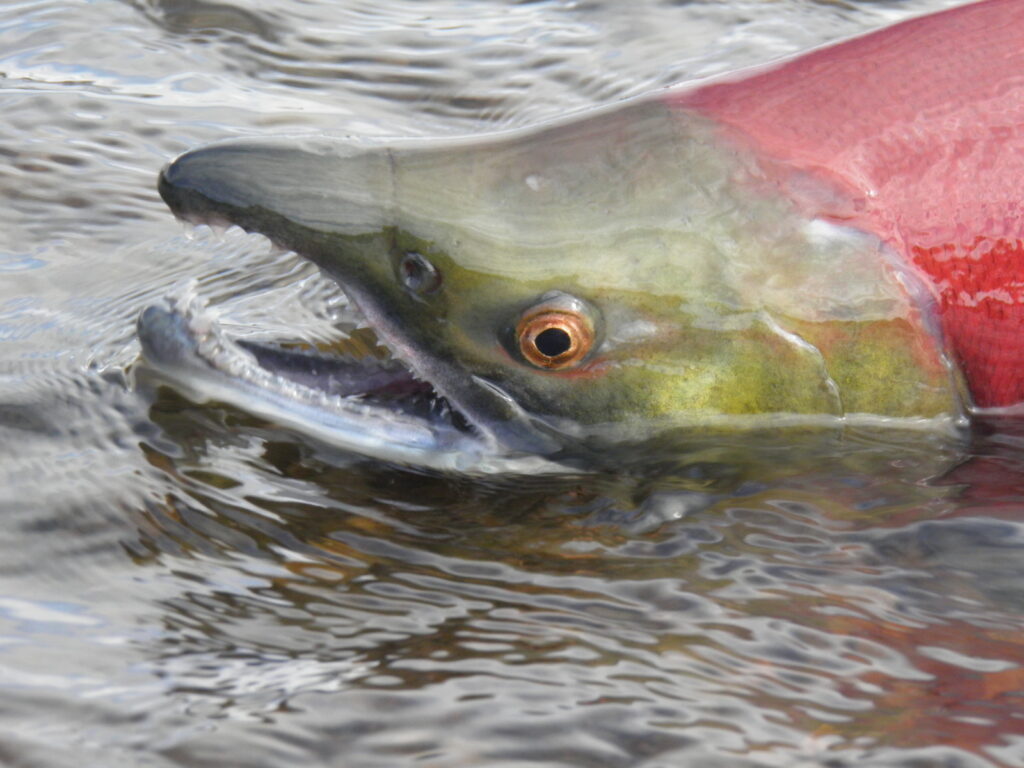A spawning Bristol Bay sockeye salmon is exposed in shallow water in Lake Clark National Park and Preserve in 2006. When spawning, the salmon turn from silver to red, with green heads. This year’s Bristol Bay sockeye run was above the 20-year average, but the average size of individual fish was the smallest on record. (Photo by T. Quinn/National Park Service)
The world’s largest sockeye salmon run was larger than average this year, but the percentage of those fish that were harvested commercially was lower than normal, and individual fish weighed in at the smallest size on record, the Alaska Department of Fish and Game reported.
Bristol Bay’s sockeye salmon run totaled 51.6 million fish, more than a third higher than the preseason forecast of 37.9 million fish and about 7% higher than the average over the past 20 years, according to the department’s preliminary numbers, released this week.
The total sockeye harvest was 31.6 million fish, about 5% below the 20-year average, the department said. That left large numbers of sockeye salmon to return all the way to their freshwater spawning sites, a status called escapement. An estimated 20 million sockeye salmon made that full return trip, and escapement goals for that species were met or exceeded in all areas of the system, the department reported.
An important factor was the small size of the individual fish, Fish and Game officials said.
Salmon sizes in Bristol Bay and elsewhere have trended down in recent decades. This year, the average sockeye salmon weight was 4.53 pounds, the smallest on record, according to the department.
Even though fishers put in a normal harvest effort, the size of the fish posed challenges, said Tim Sands, the Fish and Game biologist for the Nushagak/Togiak area within the Bristol Bay region.
“In my district they were very small, and the fishermen missed them. They went through their nets,” Sands said. That experience appeared to have been repeated around Bristol Bay, he said.
There are multiple reasons for the small size, Sands said.
One is the age-group makeup of this year’s run, he said. About 80% of the returning sockeye spent two years growing out in the ocean rather than three years, he said. Typically, two-ocean-year and three-ocean-year fish are more evenly matched, and in some years, there are more of the latter group, he said.
There also appear to be more widespread and longer-term trends affecting Bristol Bay sockeye sizes.
In much of coastal Alaska, salmon sizes have shrunk over the past decades. The change is most dramatic in Chinook, but it has affected other salmon species as well.
Average weight of Bristol Bay sockeye salmon, 1980–2024. (Graph provided by the Alaska Department of Fish and Game)
Among the possible reasons for that change in salmon size, according to scientists, are warmer ocean temperatures linked to climate change that increase food needs, faster maturity in warmer water that causes fish to return to spawn at younger ages, competition for food resources in the ocean or some combination of those conditions.
Sands said that another factor affecting this year’s total Bristol Bay sockeye harvest was a four-day harvest closure in late July in the important Egegik district. That was imposed by regulators in response to widespread illegal fishing there.
The value of this year’s sockeye harvest was significantly lower than the average over the past two decades. Payments to fishers for their salmon upon delivery totaled $128.1 million, according to preliminary information, 34% lower than the 20-year average of $193.4 million.
However, it was an improvement from last year, when the value of the Bristol Bay sockeye harvest was only $117.4 million.
While the total amount of sockeye salmon harvested was lower than last year, this year’s sockeye salmon price was about 30 cents per pound higher, Sands said.
“That’s quite a big bump up, percentage-wise,” he said.
The average per-pound price for Bristol Bay sockeye was only 52 cents last year, according to an earlier Alaska Department of Fish and Game report.
Fishers in Bristol Bay and elsewhere in Alaska endured extremely low prices in 2023, a situation caused in large part by a glut on the market.
Runs of other salmon species in Bristol Bay were lower than normal.
The Chinook run, which has been poor in past years, continued the trend. This year’s run into the Nushagak River, the most important site for Bristol Bay Chinook, was 85% below the 20-year average, and the escapement target was not met. The Chinook harvest, with a preliminary total of 6,895 fish, was 82% below the 20-year average and the lowest in those two decades, the department reported.
“They’re a stock of concern on the Nushagak River, and we’re doing what we can to protect them,” Sands said.
The chum salmon return was relatively low, but it showed improvement over recent years’ totals. The chum run totaled 506,541 fish, according to preliminary figures, a total 50% lower than the 20-year average but higher than any year since 2019.
The coho salmon harvest this year was 28,804 fish, 70% below the 20-year average, according to the department’s preliminary numbers. There was a pink salmon harvest of 76,199 fish, according to the department’s data, but those are generally fish caught incidentally in the sockeye harvest. Pink salmon escapement in Bristol Bay is not tracked and the department does not have much information about it, Sands said.
GET THE MORNING HEADLINES DELIVERED TO YOUR INBOX

